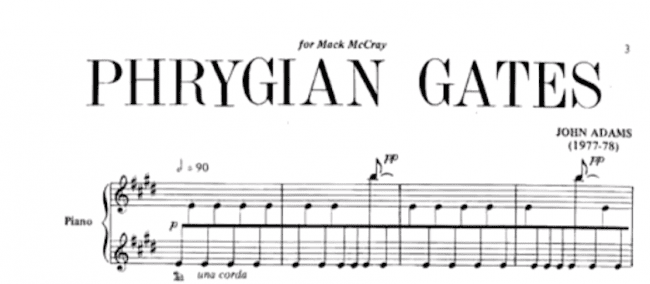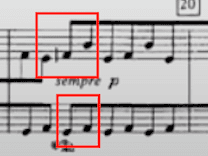Last week, I posted some notes about the fourth movement of Ligeti’s Chamber Concerto. As I thought further about what I wanted to do musically in my Hub New Music piece, I thought of John Adams’s Phrygian Gates. What I hear common to both pieces is a harmonic wash—that is, both pieces saturate entire spans of a register using collections of seconds.
Adams’s piece interests me because his harmonic wash is modal rather than chromatic. Further, it (often) has a discernible pulse and is constructed from repeating, distinct melodic cells. (In contrast, Ligeti’s piece generally features rhythms that are presto possible and pitch sequences that are deliberately patternless, within each passage’s given constraints.)
So before I go further, here is Adams’s piece, for your listening pleasure:
General Observations
Because my analytical purpose is to gather ideas for my own composition, I will not examine the entire piece in depth. These, however, are some parameters worth noting:
- Most of piece consists of steady eighth- and 16th-note surface rhythms that often create a sense of pulse but never of beat. Some passages feature a quarter-note pulse (e.g., m. 554 ff.). Adams also composes the central section, “A Series of Weights and Measures” (m. 640-808), using tied whole notes of notably uneven durations.
- On a local level, Adams creates consistency be establishing “interference patterns” between the right and left hand. For instance, in bar 8, he juxtaposes a 3-note cell against a 2-note one. (The periodic unisons these particular cells create is not a bug; it creates a shimmer whose cause is just beyond the reach of most careful listeners.)

- These cells tend to be little upward gestures. Or least, they begin with an upward gesture before a downward one (cf. bar 201 ff.). Thus, the contrast at bar 255 ff., with its clear downward microgestures, is notable (cf. bars 518 ff. and 954 ff.).
- These cells often consist of one note per hand, but regularly contain as many as four. Generally, these chords remain static for the duration of the phrase, though there is at least one passage (bar 159 ff.) in which the pianist must undulate between dyads.
- Adams beams each pattern separately, making it easy to divide the piece into separate phrases. In each phrase, Adams varies the length and pitch content of its constituent cells. Because individuals phrases often maintain a cell from their preceding phrase, because large sections of the piece maintain a steady pulse, and because Adams further instructs the performer that “no single pattern [should] ever dominate[ ] another,” it can be difficult to tell when one phrase ends and another begins. Thus, this separation into “phrases” by beaming is often more a courtesy to the performer than a distinction Adams intends the listener to hear.
- Sometimes Adams introduces both cells at the start of the phrase (see observation no. 1 above). Other times, he elides the start of one cell with the ending of a previous cell, for instance, in bar 19:

- From the start, Adams adds disruptive elements to most phrases. For instance, in the phrase that begins in bar 9, Adams disrupts the right hand’s 3-note cells with 2-note interjections (bracketed in red).

Sometimes Adams inserts these interjections between cells, as in the example above. Other times, they replace notes in existing cells. For instance, in bar 37, Adams sets up a new pattern, but in bar 37, he replaces the last note of the right hand’s cell with a foreign pitch (bracketed):

- These interruptions and replacements have several effects:
- By changing the alignment of a phrase’s cells, they change the resulting interference pattern.
- They create notable landmarks, (1) because they occur only a handful of times, (2) because they happen at unpredictable intervals, and (3) because they consist of pitches that don’t belong to the prevailing pattern.
- Adams, like Ligeti, uses voice leading to shape individual phrases into larger trajectories. For instance, the most formally significant melodic motion in bars 1-57 is the slow, stepwise descent of E4 to A3.
- Like Ligeti, Adams, also sometimes uses gestures to create trajectories. For instance, in bars 85-113, Adams gradually adds pitches above the interrupting E5, creating an “expanding-density gesture.” After B5 comes in bar 96, the addition of a pitch in the subsequent phrase’s interrupting element is expected, though not necessarily the specific pitch and timing (E6 in bar 104).
A Lengthy Digression on Adams’s Use of Modes
In his program notes, Adams explains that “‘Gates,’ a term borrowed from electronics, are the moments when the modes abruptly and without warning shift.” On a local level, “mode” in Phrygian Gates, however, often means something more akin to “diatonic collection” than it does to “scale.” “Scale” describes well Vaughan Williams’s use of modes to create clear pitch hierarchies. In Debussy, too, though these hierarchies can be more ambiguous, they consistently operate on both local and formal levels. In contrast, because Adams composes his phrases out of static cells, voice leading only functions on a formal level in Phrygian Gates. In consequence to both its static cellular construction and its formal-only voice leading, the piece only weakly, if at all, creates the sense of pitch centricity necessary to cast its modal pitches into hierarchal relationships with one another.
Indeed, the opening 113 bars of the piece seem to deliberate obfuscate the pitch A as the “root” or “center” of the four-sharp diatonic collection. In fact, the piece sounds E-centric when it opens and C#-centric in bar 44. When the long-range voice leading finally arrives at A3 in 56, Adams creates further confusion by interjecting the extra-modal Bb.
Now, I wrote that “‘mode’ in Phrygian Gates . . . often means something more akin to ‘diatonic collection’” because there are some exceptions. The E phrygian section that begins in bar 236 does sound like E-phrygian, not simply the white-key diatonic collection, because Adams thoroughly grounds it on E1 and E2 in the bass (cf. the C# in bars 640-808). Contrast this with the B-lydian music that follows it (bar 266): as with the opening “A lydian” music, B does not project itself as the center of a pitch hierarchy. Instead, whatever pitch is in the bass generally sounds most important. Thus, B gains its pre-eminence only in bar 311.
In short, Phrygian Gates generally lacks pitch hierarchies. Its pitches generally attain prominence for registral and timing reasons rather than voice-leading ones. Perhaps surprisingly given their radically different harmonic colors, Phrygian Gates and the fourth movement of Ligeti’s concerto both share this harmonic feature. However, whereas Ligeti achieves this lack of pitch hierarchy by using the symmetrical chromatic scale, Adams achieves it by constructing his piece using repeating, static melodic cells.
Lastly, I should note in passing the formal design of Adams’s modal usage. Adams mentions in the program note that the piece is “a 22-minute tour of half of the cycle of keys” that switches between the Lydian and Phrygian modes in each key change. Other scholars have diagrammed this progression (e.g., p. 14 here, cf. p. 135 here) and even debated each section’s modal identities. These details don’t really matter to me. The big picture affirms this general compositional wisdom: pitch-centric compositions longer than 3-5 minutes generally require shifts in collection and centricity to keep the listener’s attention.
Takeaways
As with analyzing Ligeti’s piece, my purpose in analyzing Adams’s is to help me identify some potential composition exercises to better capture the sound I was imagining. So here are the ideas that I have:
- I don’t think I want to compose my piece out of short, static cells. However, I could try composing it out of short, static phrases—like Michael Torke’s Yellow Pages (that’s a whole other analysis project). Like Adams, I can experiment with placing these phrases in counterpoint with each other. So, to begin with, here’s my task:
- Write a variety of short, static phrases
- These phrases should vary in
- length
- rhythm (unlike Adams’s which are at a steady rhythm)
- overall pulse (e.g., is this phrase mostly a 16th-note gesture or an 8th-note one?)
- pitch content — more specifically
- mode/collection
- subsets of that mode/collection
- stepwise vs. arpeggiated motion
- density — they can consist of up to 3 pitches (though probably in closed voicing to start)
- Identify: Do single/simple-contour phrases work better than ones that seem like little melodies?
- Having written these phrases, I will then experiment in combining them
- Which ones sound good with each other? At which transpositions?
- What different orderings can I create?
- Next, how can I disrupt these phrases? What is the effect of different lengths of disruptions?
Again, by the time you read this, I’ll likely have already conducted these experiments.
Don’t Miss Next Week’s Post
Sign up to stay in the loop about my music—and ideas for your own composing!






